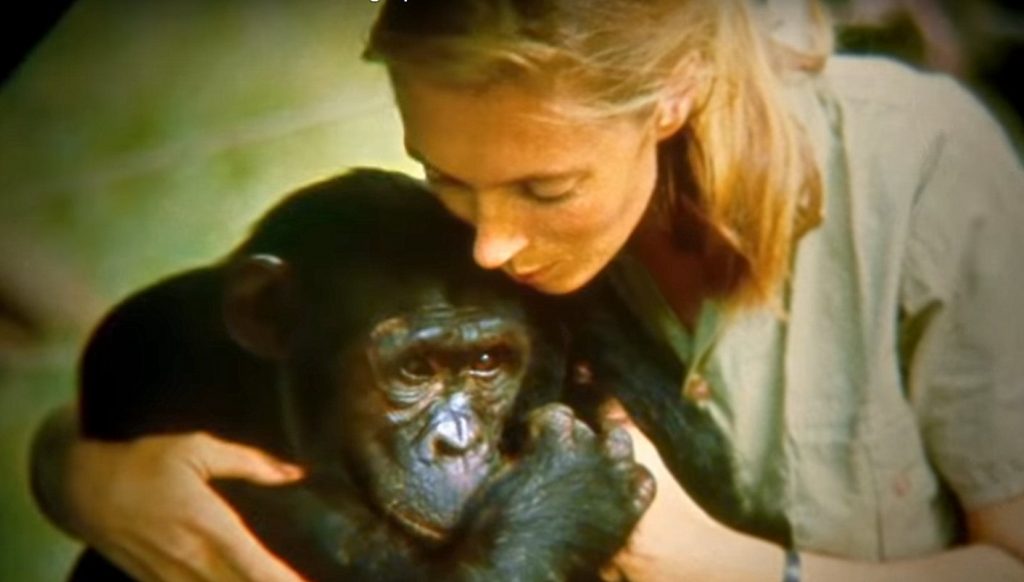Jane Goodall’s life story: the pioneer who dedicated her life to the animal kingdom
(Goalcast) It all began when a young girl bought a second-hand book called Tarzan of the Apes.
She would climb up her favorite tree and read it from cover to cover. Little did she know, that very book would inspire over 55 years of groundbreaking work and change the way the world understood chimpanzees forever.
That girl’s name was Jane Goodall. Today, we know her as Dr. Jane Goodall, the world’s leading authority on chimpanzees and a pioneer of animal research.
But at the time, her wild dreams of studying animals in Africa were called “ridiculous” and “unachievable” by those around her. Nevertheless, Jane left her home in England to spend the next two decades of her life in an African rainforest.
With just a notebook, binoculars, and patient observation, she studied our closest living relatives in her own unique way, making unprecedented discoveries and revolutionizing everything we thought we knew about the animal kingdom.
This is her story.
Born loving animals
Valerie Jane Morris-Goodall was born in 1934 in London, England, into a middle-class British family. She grew up with her older sister in a time of food rations and cautious spending as the country struggled through the toils of World War II.
When Jane was two years old, her father gave her a stuffed chimpanzee for comfort. Jane fell in love with the toy and carried it everywhere, opening her heart to real-life animals like her beloved chimpanzee.
At 10 years old, young Jane became fascinated by all wildlife. She would climb her usual tree in the garden and watch the birds and the leaves, or lose herself in books like Dr. Doolittle and Tarzan.
Jane was especially captivated by Tarzan, and she began to delve further into the natural world, dreaming of the day when she too could live amongst animals in Africa.
While the 1940s was an unkind place towards little girls with big dreams, Jane had found her passion and was determined to live it. Her mother was one of the few people who encouraged her dream. She told Jane:
“If you really want to do this, you’re going to have to work really hard, take advantage of opportunities, and never give up.”
Pursuing her dream
Jane Goodall graduated school at 18, but there was no money for her to attend university, so she went to secretarial college and got a job. In her spare time, she worked at a documentary film company to finance her dream trip to Africa.
It wasn’t until five years later, in 1957, that Jane finally rounded up enough money to get on a boat and sail to the African coast. She stayed at a friend’s farm, who later suggested that Jane call Louis Leakey, a renowned Kenyan archaeologist and paleoanthropologist. Louis and his wife were impressed with Jane and hired her as their secretary and archeology assistant.
One day, Louis came across the opportunity to conduct a long-term study of primate behavior. As our closest living relatives, he believed they were the key to understanding our own origins, and so he chose Jane for the task due to her infinite patience and eagerness to learn.
The scientists at the time were scandalized that Louis would send a 23-year-old woman with no formal training or degree. How could she possibly succeed as the lone field researcher amongst such “dangerous animals” ?
Trailblazing in Tanzania
In 1960, at 26 years old, Jane Goodall was sent to Gombe National Park in what is now known as Tanzania. Nervous but excited, she clutched onto her notebook and binoculars as she ventured into the unknown realm of wild chimpanzees.
At first, she couldn’t get near them at all. She spent days atop a mountain with nothing but tins of food and coffee, steadily watching the chimps through her binoculars. But she was determined to get closer, so she set up a banana-feeding area to lure them into the open.
Every morning without fail, she’d stand there — barefoot — where the chimps could see her. This was a highly unconventional method in biological studies, but Jane had faith that it would work.
Slowly, the chimpanzees became used to her presence. Within a year, they’d allow her to sit close by. Within two years, they would come up to her asking for bananas. Jane had finally earned their trust, and now had unprecedented access to their mysterious world.
Making groundbreaking discoveries
As she quietly crouched near the feeding station, she became a friend of the chimpanzees. She ate their food with them, imitated their calls, and even groomed them.
Through patience and determination, Jane observed what no scientist ever had: Chimpanzees weren’t the mindlessly aggressive animals everyone thought they were. They had individual personalities and complex social structures. In fact, they weren’t so different from humans at all.
Her most important observation was how they used tools to gather their food, an ability thought to be unique to humans. They also ate meat, not just plants as previously thought.
These were revolutionary discoveries which challenged everything researchers thought they knew about chimpanzees. However, no one was ready to believe a woman’s word that humans were simply not all that different from the rest of the animal kingdom.
But in 1965, Jane’s pioneering work and unique research methods were featured in the National Geographic, finally earning international prominence.
Dedicating her life to conservation
Two decades had passed since Jane had first stepped foot in the Tanzanian rainforest. She thought this was it for her, this was where she belonged. But in 1986, she attended a conference where she realized chimpanzees were in danger of extinction. They were being forced out of their homes, locked up in zoos, and used in cruel medical experiments.
At this point, Jane already had global recognition. Her work had been featured in dozens of documentaries and her discoveries had become invaluable to researchers worldwide. So she used her influence and voice to defend those who couldn’t speak.
She founded The Jane Goodall Institute and traveled the world giving lectures and meeting with politicians (often taking her toy chimp with her). She shared her stories, spread awareness, and inspired listeners to help conserve the natural world.
She helped improve zoo conditions for chimpanzees, set limits for medical research, and founded various chimp refugee centers. She also published books for both adults and children, and created the global youth program Roots & Shoots. Even after almost 60 years of groundbreaking work, Jane is still going strong.
Many of us can only dream of doing everything Jane Goodall has done for the world. She is the perfect example of how one person with a passion can make a difference. But now it’s time to think about how you can make a difference.
What was your childhood dream? What passion did you leave behind? No matter where you are in life, it’s never too late to make a change. You’re never too small to make an impact on the world. The only real question is: what kind of impact will you make?
Every individual matters. Every individual has a role to play. Every individual can make a difference.
— Jane Goodall
Source: Goalcast
You may also like:




